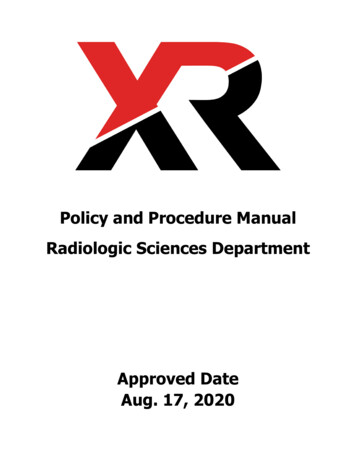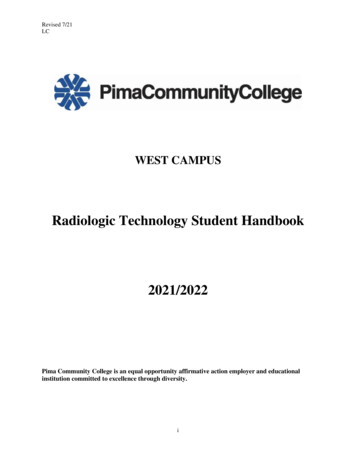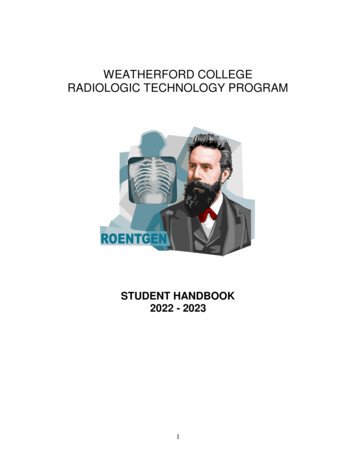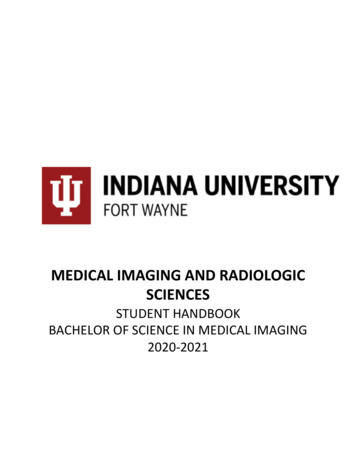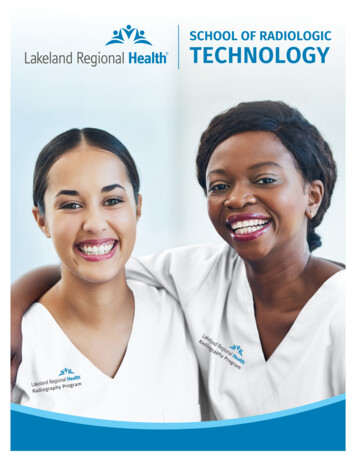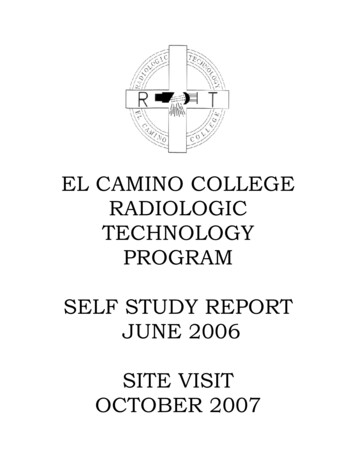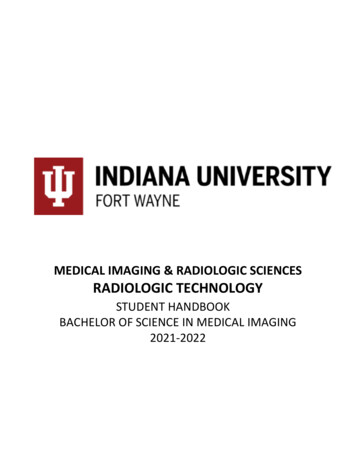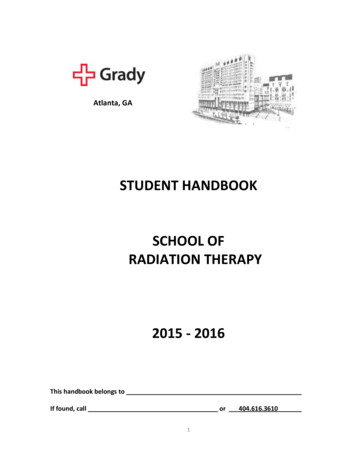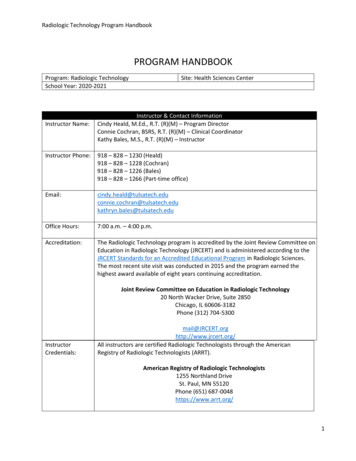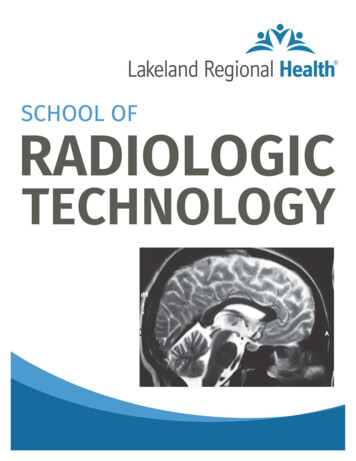
Transcription
1
LAKELAND REGIONAL HEALTHSCHOOL OF RADIOLOGIC TECHNOLOGYTWO YEARS TO YOUR FUTURE .Welcome to the Lakeland Regional Health Medical Center School of Radiologic Technology Program. Medicalimaging professionals utilize x-rays and other energy forms to help diagnose and treat medical conditions. Themedical imaging professional (radiologic technologist or radiographer) provides quality patient care whilecreating diagnostic images independently, assisting radiologists and other physicians in imaging the body, andoperating specialized radiographic equipment.This program is ideal for people interested in both personal interaction and a “high-tech” career. Medical imagingprofessionals apply their knowledge of anatomy, physiology, pathology, patient positioning, radiation protection,and image production techniques in the performance of their duties. Students acquire the knowledge and skillsnecessary for professional competence through a blend of classroom and clinical education.Students of Lakeland Regional Health Medical Center School of Radiologic Technology will have theunique opportunity to complete didactic and clinical components for both Radiography and ComputedTomography (CT). The education received at LRH will allow the student to complete The AmericanRegistry of Radiologic Technologists (ARRT) requirements for the national certification exams in bothRadiography and CT in the traditional 2 year time frame.Our VisionLRH School of Radiologic Technology, providing the best educational experiences.Our Core Purpose / MissionGraduating individuals with the qualities, knowledge, and competencies necessary tobecome Registered Radiologic Technologists that provide the best outcomes and safest care.Our Values & BeliefsWe Promise to treasure all people as uniquely created to nurture, educate and guide with integrity to inspire each and every one of us to do our very bestOur GoalsGoal 1.Goal 2.Goal 3.Goal 4.Students will demonstrate competence for successful practice as entry level radiographers.Students will develop and demonstrate growth, professional ethics, and characteristics of ahealthcare practitioner.Students will demonstrate abilities in effective communication with staff and patients.Students will apply critical thinking and problem solving skills necessary for professionalpractice.2
INTRODUCTIONRadiologic Technology is both an art and a science, it offers limitless opportunities for growth. The education offered atLakeland Regional Health provides exposure too many Radiologic disciplines including Diagnostic & Fluoroscopic Imaging,Vascular & Interventional Imaging, Cardiac Imaging, Magnetic Resonance Imaging (MRI), CT Imaging, Mammography,Ultrasound, Radiation Therapy, and Nuclear Medicine. This exposure will open the door to specialization if you wish tocontinue your education. The choice is entirely up to you.The role of the Radiologic Technologist (or "Radiographer") is varied, and includes providing quality patient care whileperforming various radiology related procedures. The primary function of a Radiographer is to use x-rays to visualize andrecord anatomy of the human body. This entails knowledge of:* theories of x-ray production* pathology interaction of photon energy with matter* patient care and nursing skills biological effects of radiation on living cells* exact patient positioning to allow for the anatomy and physiology of the human bodyvisualization of anatomy on a radiographGENERAL INFORMATIONThe Lakeland Regional Health School of Radiologic Technology provides a diverse education in radiologic technology andenables graduates to become a registered Radiologic Technologist. The School of Radiologic Technology was organized in1965 and is sponsored by Lakeland Regional Health Medical Center.The Lakeland Regional Health School of Radiologic Technology is accredited by the following agency:Joint Review Committee on Education in Radiologic Technology (JRCERT)20 North Wacker Drive, Suite 2850Chicago, Illinois 60606-3182(312) 704-5300e-mail: mail@jrcert.orgThe JRCERT is recognized by the U.S. Department of Education as an approved accrediting agency. The program is alsoapproved by the State Approving Agency for Veterans Training and HEW. Qualified veterans are eligible to apply forfinancial benefits.The program is a hospital-based educational program and requires two years of full-time attendance in classroom and clinicalcourses (3,435 clock hours). Classes begin in the summer of each year. After successful completion of the two-year program,students are issued a certificate of achievement and will have completed the requirements needed to apply for the nationalexamination in Radiologic Technology and given by the American Registry of Radiologist Technologists (ARRT). Thosewho pass the American Registry examination receive a certificate that confers upon the applicant the right to use the title"Registered Technologist in Radiography" or the abbreviation "R.T.(R)" along with their name. This certification is anindication that the individual is qualified to work in the field of ionizing radiation.The American Registry of Radiologic Technologist (ARRT) is a national certifying agency for radiologic technologistsrecognized by the American Society of Radiologic Technologists (ASRT), the American College of Radiology (ACR), andthe American Medical Association (AMA).HOSPITAL INFORMATIONOur VisionTogether, our Promise is YOUR HEALTHOur Core Purpose/MissionWe deliver the best outcomes and safest care by placing people at the heart of all we do.We improve lives every day by promoting wellness, education and discovery.Our Values & BeliefsWe Promise to treasure all people as uniquely created to nurture, educate and guide with integrity to inspire each and every one of us to do our very best3
Lakeland Regional Health Medical Center, a not-for-profit facility, has served Lakeland and the surrounding communities formore than 80 years. LRH is licensed for 851 beds and is accredited by The Joint Commission (TJC). Lakeland Regionaloffers some of the most comprehensive and sophisticated care available, from early detection and education programs, toprimary and specialized care, and is equipped with a variety of the most advanced radiographic and diagnostic imagingequipment. The hospital’s patients enjoy a wide scope of specialized medical services uncommon in a community of thissize.The Department of Radiology incorporates two independent groups of radiologists, and is guided by a director and managerwho act as liaisons between the hospital administration, the radiologists, and staff personnel within the various radiologymodalities. Students are under the direct supervision of the School Program Director, Clinical Coordinator, and theRadiology Clinical Coordinators.CLASSROOM AND CLINICAL EDUCATIONAfter orientation, students are scheduled for approximately ten hours of classroom instruction per week during each quarterof the program. An average of at least 78% or "C" in all courses must be maintained to graduate. Additionally, each studentmust pass a first-year final examination to progress to the second year, and a second-year final examination to graduate fromthe program.The didactic grading scale is as follows:93 - 100%84 - 92%78 - 83%Below 78%ABCFAfter orientation, clinical education courses require approximately 27½ hours of scheduled clinical rotations per week.Students are supervised, instructed, and evaluated by staff radiographers, clinical instructors, the clinical coordinator and theprogram director. Students must show competence in performing specified diagnostic procedures in order to graduate fromthe program. Students are assigned to different clinical rotations in various clinical settings to allow for adequate exposureand experiences in all areas of Radiologic Technology. Most clinical assignments and rotations are completed at LakelandRegional Health, Monday – Friday from 8am – 4pm. However, due to different procedure experiences, students will beassigned to clinical rotations at various times during the two-year course of study that range between 5:00am and 7:00p.m.All students will be assigned a total of 6 rotations (each rotation is one week in length) from 3:00 p.m. – 9:30 p.m. Theserotations will be scheduled in quarters 3 – 8.The clinical grading scale is as follows:95 - 100%87 - 94%80 - 86%Below 80%ABCFStudent Services and Benefits:The school has a dedicated classroom and a learning/resource lab for instructional purposes. Students have access to thehospital’s radiographic rooms for demonstration and practice labs; access to the hospital’s medical library, computer lab, andinternet services for research assignments or projects; use of the school’s imaging phantoms and anatomic models; and accessto numerous self-study audiovisual and computer aided instructional materials covering all disciplines of RadiologicTechnology. Tutoring services are available when requested and scheduled. The hospital’s Employee Health Departmentprovides services for medical testing, immunizations, illnesses, or injuries related to the student’s clinical assignments whilein the radiography program. Students will be referred to their personal physician for any other medically related needs.Students receive the same discount as employees when using the hospital’s cafeteria.4
Graduation Requirements:Requirements to receive a certificate of completion and graduate from Lakeland Regional Health School of RadiologicTechnology are as follows:1. Successfully complete all required didactic and clinical courses.2. Complete the required senior projects.3. Pass both the first year and second year comprehensive final examinations with a minimum score of 78%.SCHOOL BREAKS & HOLIDAYSThe LRH radiography program operates on a quarter system. Students receive a two-week break between the fall and winterquarter each year near the end of December and a one-week break between the remainder of the program quarters, usuallynear the end of March, June and September. Additionally, students do not attend class or clinical rotations on the followingholidays:Labor DayThanksgiving DayFriday after ThanksgivingGood FridayMemorial DayJuly 4thCOURSE DESCRIPTIONSRAD 100 – ORIENTATION TO RADIOLOGIC TECHNOLOGYThis course is an introduction to Radiologic Technology as a profession. This course provides the foundation for all othercourses studied during the two-year program. In addition to the subject areas listed below, students are given an overview ofRadiographic Exposure (density, contrast, detail and definition); X-Ray Production; and Basic Radiographic and MedicalTerminology.Subject areas studied more in depth are the following:Introduction to Imaging and Radiologic Sciences Professional Organizations Educational Survival Skills Critical-Thinking and Problem-Solving Strategies Introduction to Clinical Education Radiology Administration Radiographic Imaging Radiographic and Fluoroscopic Equipment Basic Radiation Protection and Radiobiology Professional Ethics Health Records and Health Information Management Medical Law Department Specific Orientation LRH Hospital Orientation Positioning, Terminology, and Principles General, Systemic, and Skeletal Anatomy and Arthrology Human DiversityAs part of the course, students are rotated through pre-clinical assignments in the Radiology Department for observation andorientation of the various aspects and functions of the radiology areas within the hospital. Included in this pre-clinicalexposure are practice labs to familiarize students to various patient positions and basic operation of a radiographic tube, tableand control panel.Year 1, Quarter 1150 Clock Hours5
RAD 110 - RADIOLOGIC PATIENT CAREThis course involves a study of nursing techniques and practices, pharmaceuticals, drug administration, patient care strategiesas they relate to the diagnostic, mobile, and fluoroscopic practices of patient care during the performance of RadiographicProcedures. Included in this course are the following components: Safe Patient Movement and Body Mechanics Basic Cardiac Monitoring Immobilization Techniques Oxygen Patient Interactions and Communication Chest Tubes and Lines History Taking Medical Emergencies Infection Control Mobile Radiography Standard Precautions – to include state Pharmacologymandated AIDS / HIV Education IV Therapy and Venipuncture Aseptic and Nonaseptic Techniques Contrast Media Vital Signs Medical Terminology as related to Patient CareYear 1, Quarter 170 Clock HoursRAD 120 – ANATOMY, PHYSIOLOGY, AND RADIOGRAPHIC PROCEDURES IThis course begins with the study of development, anatomy, physiology, common pathologies and medical terminologyassociated with the skeletal system, chest and abdomen. Included in this course are lecture/audio-visual presentations,demonstrations, and practice labs of the anatomy and positioning (as it relates to radiologic diagnosis and treatment) of theupper and lower extremities, pelvic girdle, shoulder girdle, chest and abdomen. Instruction and demonstration of routine,trauma, and mobile radiographic procedures are included. This course also includes the study of pediatric imaging includingspecial positioning, immobilization, exposure factors, and communication techniques. The final portion of this courseincludes an introduction to surgical equipment and procedures. Presented concurrently with this course is Image Critique andIdentification, which includes assessment of image quality (positioning and exposure), and identification of radiographicanatomy and simple pathologies. The necessity of proper radiation protection practices are stressed for any given procedurestudied or demonstrated.Year 1, Quarter 2114 Clock HoursRAD 130 – RADIOGRAPHIC EXPOSURE IThis course is a comprehensive study of all principles related to radiographic exposure and quality as they relate to density,contrast, detail visibility, definition and distortion as well as their implications in patient exposure. All concepts discussedwill include analog and digital imaging systems. Included in Radiographic Exposure I are the following: Image Formation in Digital and Analog Systems Exposure Technique Factors to include Relationship of kVp and mAs Primary Principles and Factors of Radiographic Quality Beam Restriction Comparison of Digital and Analog Imaging Systems Functions Introduction to Compton and Photoelectric Effect Factors Contributing to Differential AbsorptionYear 1, Quarter 226 Clock Hours6
RAD 121 – ANATOMY, PHYSIOLOGY, AND RADIOGRAPHIC PROCEDURES IIThis course is a study of development, anatomy, physiology, common pathologies, and medical terminology associated withbody systems. Included in this course is an introduction to pathology, and the study of the pathologies of the various systemsstudied during this course. Lecture/audio-visual presentations, demonstrations, and practice labs of radiographic positioningand procedures for each associated body system are studied in depth. Presented concurrently with this course is ImageCritique and Identification, which includes assessment of image quality (positioning and exposure), and identification ofradiographic anatomy and pathologies. The necessity of proper radiation protection practices are stressed for any givenprocedure studied or demonstrated. Included in this course of study is the following: Introduction to Pathology Bony Thorax Vertebral Column Respiratory System Gastrointestinal and Biliary SystemYear 1, Quarter 3110 Clock HoursRAD 122 – ANATOMY, PHYSIOLOGY, AND RADIOGRAPHIC PROCEDURES IIIThe first section of this course involves lecture, demonstration and practice labs of the anatomy, physiology, positioning, andpathology (as it relates to Radiologic diagnosis and treatment) of the skull and facial bones. Instruction and demonstration onroutine and trauma procedures are included. Gross anatomy and pathology of the Central Nervous System – brain and spinalcord will be examined. The second part of this course is the study of cross-sectional anatomy of the head, face, neck, thorax,spine, abdomen / pelvis, upper and lower extremities. Instruction, demonstration and practice labs of positioning, (as it relatesto Computed Tomography diagnosis and treatment) of the aforementioned anatomy is included. Presented concurrently withthis course is Image Critique and Identification, which includes assessment of image quality (positioning and exposure), andidentification of cross sectional and radiographic anatomy and pathologies. Included in this course of study is the following: Skull and Facial Bones First Year Review Cross-Sectional CT First Year Final CT positioningYear 1, Quarter 488 Clock HoursRAD 140 – CT BASICSThis course involves lecture on the fundamental basics of Computed Tomography, to include the discovery and developmentof CT, the generations of CT, location and function of major CT components, and common uses of computed tomography inmedical imaging. CT procedures will be discussed to include routine and trauma exams of the head, face, neck, spine,thorax, upper / lower extremities, abdomen/pelvis and Central Nervous System. CT imaging procedures are correlated withthe study of associated cross-sectional anatomy. Lecture/audio-visual presentations, demonstrations of procedures for eachassociated system or specialized area are studied in depth. Presented concurrently with this course is patient safety whichincludes the necessity of proper radiation protection practices for any given procedure studied or demonstrated and ImageGently.Year 1, Quarter 440 Clock Hours7
RAD 231 – RADIOGRAPHIC EXPOSURE IIThis course is a study of x-ray fundamentals as related to types of image receptors and processing; image display; formationof proper techniques and use of automatic exposure control devices. All topics will include concepts for analog, digital, andcomputed tomography imaging systems. Included in Radiographic Exposure II are the following: Image quality utilizing different types of image receptors Image quality principles of computed tomography Necessary Technique and Adjustments Needed for Proper Utilization of Computed Radiography, Direct DigitalRadiography, and Screen-Film Imaging. Scatter Control including grids, Aperture Diaphragms, and Collimation Image Processing and Display within Analog and Digital Imaging Systems Intensifying Screens Construction and Function Communications within Imaging including PACS, DICOM, RIS, HIS and HL7. Principles of Automatic Exposure Control Devices Methods of Formulating Technique ChartsYear 2, Quarter 5132 Clock HoursRAD 223 – ANATOMY, PHYSIOLOGY, AND RADIOGRAPHIC PROCEDURES IVThis course is a continuation of the study of the development, anatomy, physiology, common pathologies, and medicalterminology associated with body systems and specialized areas of radiography. Lecture/audio-visual presentations,demonstrations, and practice labs of radiographic positioning and procedures for each associated system or specialized areaare studied in depth. The necessity of proper radiation protection practices are stressed for any given procedure studied ordemonstrated. Presented concurrently with this course is Image Critique and Identification, which includes assessment ofimage quality (positioning and exposure), and identification of radiographic anatomy and pathologies. Included in this courseof study is the following: Circulatory System Urinary System Lymphatic System Pathology of Skeletal SystemYear 2, Quarter 640 Clock HoursRAD 240 - RADIOLOGIC PHYSICSThis course is a comprehensive study of the principles of radiation physics that relate to x-ray production and emission.Content of this course is designed to establish a basic knowledge of atomic structure. Other topics include nature andcharacteristics of x-radiation; ionizing and non-ionizing radiation; the production of x-rays; the properties of x-rays and thefundamentals of x-ray photon interaction with matter as well as the terminology associated with these components Fundamental units of mass, energy and measurements Basic atomic structure Fundamentals of Radiation: Properties and characteristics; types; units and dosages (RAD, REM, R); and productionof and interactions with matter Fundamentals of electricity and magnetism Basic components of an electric circuit Basic principles and functions of generators, motors, transformers, and rectification Basic design and components of an x-ray circuit The construction, characteristics, and functions of x-ray and CT tubes The purpose and application of heat rating and anode cooling charts An in-depth study of x-ray production and emissionYear 2, Quarter 696 Clock Hours8
RAD 250 – RADIATION BIOLOGY AND RADIATION PROTECTIONProvides instruction on the principles of cell radiation interaction. Radiation effects on cells and factors affecting cellresponse are presented. Acute and chronic effects of radiation are discussed. Topics include: radiation detection andmeasurement; patient protection; personnel protection; absorbed dose equivalencies; agencies and regulations; introduction toradiation biology; cell anatomy, radiation/cell interaction; and effects of radiation. Fundamentals of Radiation:Properties and characteristics; types; units and dosages (RAD, REM, R); and production of and interactionswith matter Principles of Radiobiology: Cellular composition and structure; cell division; L.E.T. and R.B.E.; radiosensitivity andradioresistance; direct and indirect target theory; somatic and genetic effects; dose effect curves; acute and chronicexposure factors; radiation syndromes Regulations in the Work Environment: Advisory groups for radiation protection; dose equivalent limits; ALARAprinciple; barriers and regulatory standards; warning signs; State licensing and/or certification regulations Protection of Patient and Radiographer: Shielding devices, time and distance; fluoroscopic considerations; filtration;coning; and half-value layers Radiation Monitoring Devices: Film, TLD, & OSL badges; Geiger counters; ionizations chambers; Victoreen RmetersYear 2, Quarter 796 Clock HoursRAD 260 – SENIOR REVIEW IThis course is an intensive review of all courses taken during the two year Radiography program in order to prepare thestudent for the LRH Program Final Exam and the ARRT Certification Exam. As part of this course the student will completean online review provided by Corectec.Year 2, Quarter 724 Clock HoursRAD 261 – SENIOR REVIEW IIThis course is a continuation of Senior Review I and the use of Corectec. This course provides an in class review of basicknowledge from previous coursework and helps students prepare for the ARRT national certification examinations forradiography and CT. To pass this course students must pass the LRH Program’s Final Exam with a minimum score of 78%, arequirement to graduate from the Radiography Program.Year 2, Quarter 892 Clock HoursRAD 270 – SPECIALIZED IMAGING MODALITIESThe first section of this course provides a study of the principles and fundamentals of fluoroscopy, image intensification, andthe radiographic equipment associated with these specialized imaging modalities. The second segment of this course is astudy of specialized modalities to include; Interventional Radiography; Nuclear Medicine; Magnetic Resonance Imaging;Radiation Therapy; Ultrasound; and Mammography.Year 2, Quarter 827 Clock HoursMEDICAL TERMINOLOGYMedical Terminology (is a prerequisite course) but it is integrated into and taught concurrently with Orientation toRadiologic Technology, Patient Care, and Anatomy, Physiology, and Radiographic Procedures I, II, III, & IV. This courseincludes terminology specific to anatomy, physiology and diseases of each system; body positioning and planes; prefixes andsuffixes; and hospital terminology.Year 1 & 29
IMAGE IDENTIFICATION, CRITIQUE & PATHOLOGYImage Identification, Critique, and Pathology are not offered as separate courses, but are integrated into and taughtconcurrently with Orientation to Radiologic Technology and Anatomy, Physiology, and Radiographic Procedures I, II, III, &IV. The course includes extensive radiographic image presentations of pathologies related to each system and instruction inradiographic image identification of anatomy and assessment of image quality of all procedures as related to each systemstudied.Year 1 & 2SENIOR PROJECTDuring the second year, each student is required to write a research paper on a radiation protection related subject, andprepare a free-standing exhibit depicting some new aspect of radiology to be submitted for competition at the Florida SocietyRadiologic Technologists (FSRT) conference.Year 2RADC 110 - CLINICAL PRACTICUM I (Modules 1 & 2)This course is the practical application of subject matter taught in the classroom setting. Demonstration of knowledge and/orcompetence in various procedures or processes is required and is outlined in the clinical education handbook. Emphasisduring this term includes the following: orientation rotations in the technical area orientation rotations in diagnostic imaging rooms radiographic/fluoroscopic equipment and accessories assessment of the patient to includes basic vital functions emergency responses to various patient distresses implementation and use of proper body mechanics to move and/or transfer patientsYEAR 1, Quarter 1184 Clock HoursRADC 120 - CLINICAL PRACTICUM II (Modules 3 & 4)This course is the practical application of subject matter taught in the classroom setting. Demonstration of knowledge and/orcompetence in various procedures or processes is required and is outlined in the clinical education handbook. Emphasisduring this term includes the following: radiographic/fluoroscopic equipment and accessories advanced assessment of patient status, with the ability to respond appropriately to patient distress situations venipuncture radiography of the upper extremities, lower extremities, shoulder girdle, chest and abdomen bedside radiography of the extremitiesYEAR 1, Quarter 2296 Clock HoursRADC 130 - CLINICAL PRACTICUM III (Modules 5 & 6)This course is the practical application of subject matter taught in the classroom setting. Demonstration of knowledge and/orcompetence in various procedures or processes is required and is outlined in the clinical education handbook. Emphasisduring this term includes the following: radiography of the pelvis and spine fluoroscopic procedures of the Gastrointestinal and Biliary Systems emergency department radiography of upper extremities, lower extremities, shoulder girdle, pelvis and spine bedside radiography of the chest, abdomen and extremitiesYEAR 1, Quarter 3330 Clock Hours10
RADC 140 - CLINICAL PRACTICUM IV (Modules 7 & 8)This course is the practical application of subject matter taught in the classroom setting. Demonstration of knowledge and/orcompetence in various procedures or processes is required and is outlined in the clinical education handbook. Emphasisduring this term includes the following: fluoroscopic procedures of the Gastrointestinal and Biliary Systems emergency department and trauma services radiography of upper extremities, lower extremities, shoulder girdle,pelvis, spine, and bony thorax surgical radiographic procedures radiography of the skull and facial bonesYEAR 1, Quarter 4316 Clock HoursRADC 210 - CLINICAL PRACTICUM V (Modules 9 & 10)This course is the practical application of subject matter taught in the classroom setting. Demonstration of knowledge and/orcompetence in various procedures or processes is required and is outlined in the clinical education handbook. Emphasisduring this term includes the following: maintenance and review of skills in patient assessment, charting and patient education maintenance of skill in radiography of extremities, pelvis, shoulder girdle, spine, and bony thorax fluoroscopic procedures of the Gastrointestinal System, Urinary System, Biliary System, and Reproductive System surgical radiographic procedures radiography of the skull and facial bones advanced imaging modalities to include Ultrasound, Magnetic Resonance Imaging, and Computed TomographyYEAR 2, Quarter 5270 Clock HoursRADC 220 - CLINICAL PRACTICUM VI (Modules 11 & 12)This course is the practical application of subject matter taught in the classroom setting. Demonstration of knowledge and/orcompetence in various procedures or processes is required and is outlined in the clinical education handbook. Emphasisduring this term includes the following: maintenance and review of skills in patient assessment, charting and patient education maintenance of skill in radiography of extremities, pelvis, shoulder girdle, spine, and bony thorax surgical radiographic procedures radiography of the skull and facial bones advanced imaging modalities to include Ultrasound, Magnetic Resonance Imaging, Computed Tomography,Vascular and Interventional Imaging, Nuclear Medicine, and Radiation TherapyYEAR 2, Quarter 6300 Clock Hours11
RADC 230 - CLINICAL PRACTICUM VII (Modules 13 & 14)This course is the practical application of subject matter taught in the classroom setting. Demonstration of knowledge and/orcompetence in various procedures or processes is required and is outlined in the clinical education handbook. Emphasisduring this term includes the following: radiography of the skull and facial bones advanced imaging modalities to include Ultrasound, Magnetic Resonance Imaging, Computed Tomography,Vascular and Interventional Imaging, Nuclear Medicine, and Radiation Therapy surgical radiographic procedures maintenance of previous competencies passed final competency exams completion of all competencies required by the Radiography ProgramYEAR 2, Quarter 7330 Clock HoursRADC 240 - CLINICAL PRACTICUM VIII (2 modules – Modules 9-16)This course is the practical application of subject matter
Welcome to the Lakeland Regional Health Medical Center School of Radiologic Technology Program. Medical imaging professionals utilize x-rays and other energy forms to help diagnose and treat medical conditions. The medical imaging professional (radiologic technologist or radiographer) provides quality patient care while
